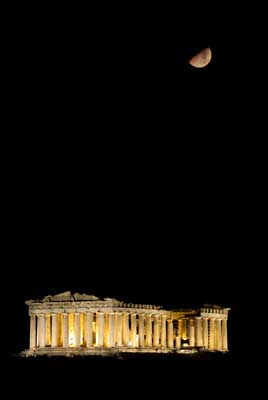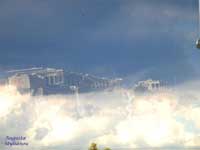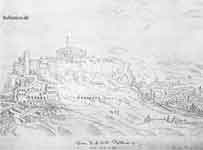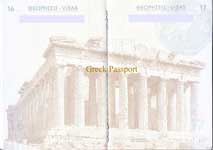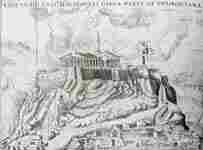.
Griechenland: Der Parthenon auf der Akropolis
Part 1
The only way to judge of the treasures the Old Masters of whatever age have left us—whether in architecture, sculpture, or painting—with any hope of sound deduction, is to look at the work and ask oneself—"What was that like when it was new?" The Elgin Marbles are allowed by common consent to be the perfection of art. But how much of our feeling of reverence is inspired by time? Imagine the Parthenon as it must have looked with the frieze of the mighty Phidias fresh from the chisel. Could one behold it in all its pristine beauty and splendour we should see a white marble building, blinding in the dazzling brightness of a southern sun, the figures of the exquisite frieze in all probability painted—there is more than a suspicion of that—and the whole standing out against the intense blue sky; and many of us, I venture to think, would cry at once, Millais.
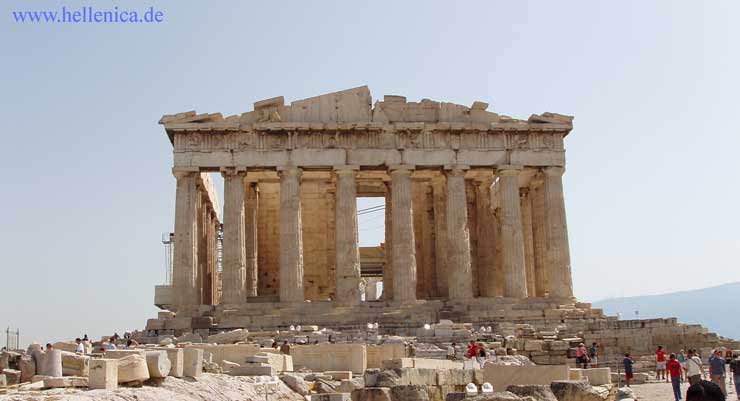
Parthenon, Akropolis
For this reason are the works of Pericles all the more to be wondered at; they were created in a short time for all time. Each one of them, in its beauty, was even then and at once antique; but in the freshness of its vigor it is, even to the present day, recent and newly wrought. Such is the bloom of perpetual newness, as it were, upon these works of his, which makes them ever to look untouched by time, as though the unfaltering breath of an ageless spirit had been infused into them Plutarch, Life of Pericles
Parthenon for the Parthena (“Virgin” or “Maiden”) Athena. The Emperor Theodosius turned the Parthenon into a Christian Church dedicated to the Virgin Mary, the Franks into a Catholic Church (1204) and the Turks into a Mosque (1458). Part of the Metopes were destroyed by the Christians when the Parthenon was transformed into a Church. The Parthenon in Athens, Greece, was built at the initiative of Pericles. In 480-479 BC Persians destroyed most of the buildings of the Acropolis in Athens. The architects were Iktinos (Ictinus) and Kallikrates (or Callicrates). Construction began in 447 BC and it was completed by 438 BC, while decorations were added until at least 432 BC for which the sculptor Pheidias (or Phidias) was responsible with around 70 other sculptors working for him. Additional work was done also until 425 BC. The Venetian Francesco Morosini (1618-94) destroyed Athena's team of chariot horses trying to remove the sculpture group from the west pediment. In 1686 the temple of Nike was destroyed by the Turks and was restored in 1835. In 1687, while the Turks were using it as a powder magazine, they were attacked by Venetian military forces of Morosini (with Otto Vilhelm von Königsmark (1639-1688) as field commander). A German lieutenant fired the fatal shot (26 September 1687) which reduced this crowning glory of Grecian art to a mere skeleton. The roof collapsed, parts of the sculptures and pillars were destroyed. Jacques Carrey, a French artist in 1674 spent two weeks making sketches and drawings of the Parthenon that provide an idea of the building as it was before the explosion.
The cost for the Parthenon building is estimated to 1000 Talents (from 447-432) or around 6 million drachmae.The buildings costs from 447-427 in Athens was around 8000 Talents or 48 million drachmae. Penteli Marble was used and transported from the synonymous place in 20 km distance. The reported monetary reserves of Athens in 432 BC: 9000 talents according to Thucydides. The Parthenon was build partly on the bedrock and part on a bedding of stone so that the foundation was flexible during an earthquake.
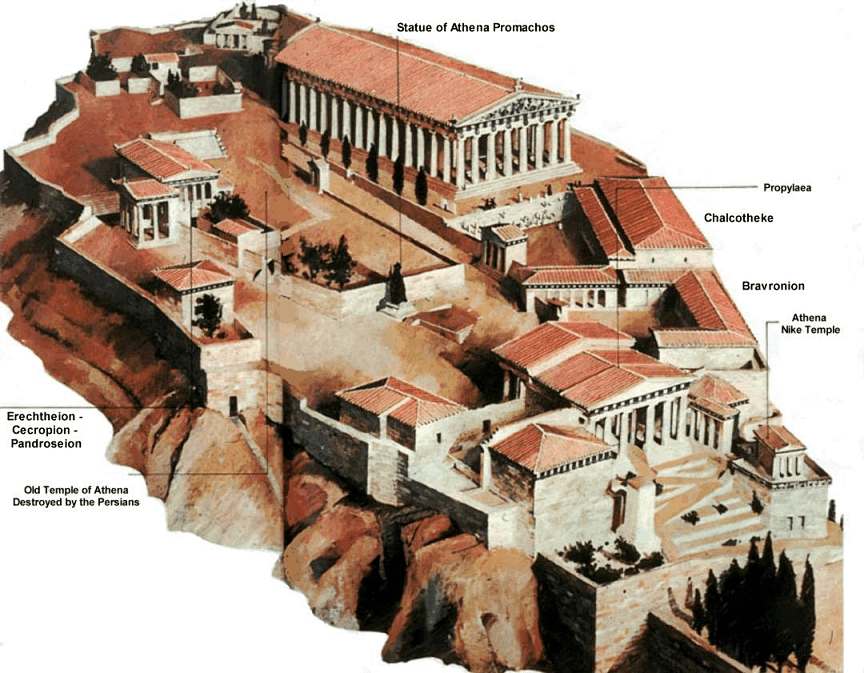
A reconstruction of the Acropolis “The Sacred Rock" with the Parthenon... how it was
360o Virtual Reality Views from the Acropolis
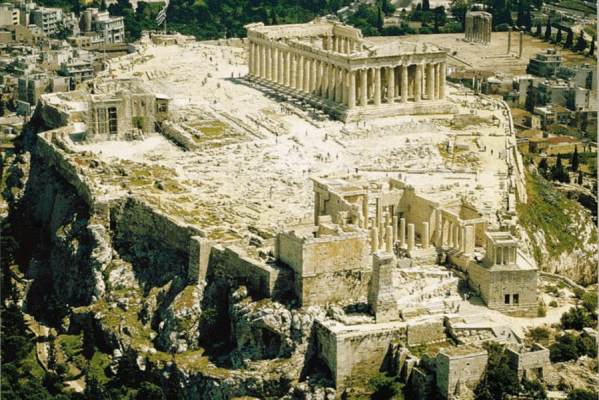
and how it is more than 2400 years later.
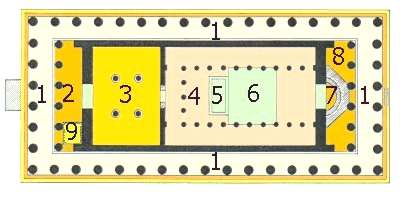
Parthenon: A Doric Peripteral Octastyle (surrounded by one row of columns, 8 columns in the front and back side) Temple.
- Peripteros
- Opisthodomos
- "Hall of the Virgins"
- Cella (Naos) with internal pillars
- Athena Parthenos
- Water pool
- Apsis of Christian church
- Pronaos (or Prodromos)
- Minarett of islamic Church
The cella was the most important part of a temple as the habitation of the deity whose statue it contained. The statues of the Gods always faced the entrance. The Parthenon roof had a wooden roof covered with Pentelic marble tiles whereas the reconstructed images here show clay tiles.

The strucutre of the Parthenon, the number of pillars is smaller than in the original building.
2. Krepidoma
3. Stylobat
4. Cellawall
5. Internal Pillars
6. Roof Tiles
7. External Pillars (Peristasis)
8. Epistyl
9. Triglyph
10. Metope
ACROPOLIS. In almost all Greek cities, which were usually built upon a hill, rock, or some natural elevation, there was a kind of tower, a castle, or a citadel, built upon the highest part of the rock or hill, to which the name of acropolis was given. Thus we read of an acropolis at Athens, Corinth, Argos, Messene, and many other places. .... At Athens, the Acropolis served as the treasury, and as the names of all public debtors were registered there, the expression of "registered upon the Acropolis" eggegrammenoi en Akropoli always means a public debtor. William Smith, A Dictionary of Greek and Roman Antiquities, John Murray, London, 1875.
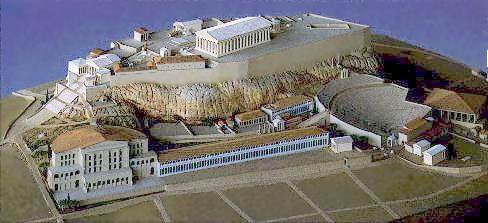
Acropolis: Approximately an area of 280 m * 140 m on a 150-160 m hill.
See a Map of the Acropolis of Athens with more details

A reconstruction of the entrance of the Doric style Temple, the Parthenon. Forty-six columns surround the approximately 31 m x 70 m temple, 10-12 drums of varying heights with 20 shallow flutings; different from other Doric temples which used 6 and 13 pillars for width and length respectively. The building was adopted to the colossal Athena Parthenos statue. The columns are 1.9 m in diameter and 10.4 m high. The corner columns are slightly larger in diameter, with their spacing reduced to make it possible for the frieze to conform to the rule that it must terminate with a triglyph. Sculptures on the metopes under the cornice show battles of Amazons, Centaurs, Giants and of Greeks before Troy. On the whole inner circuit of the body of the temple, the frieze, howing in bas-relief the Panathenaic procession.
Some more exact numbers of the dimensions (stylobat) of the Parthenon are W = 30.88 m , L = 69.5 m and H = 13.72 m which with r = 9/4 satisfies approximately the relations : r*H = W, r*W = L and therefore also r2*H = L.
The Parthenon frieze around the exterior wall of the cella is 1 meter high and 160 meters long. It contains unusually for other temples before not only gods but a large number of “mortals” and animals. Around 130 meters of the Friezes survived and from the remaining 30 meter sketches of Jacques Carrey exist.
The Parthenon is a relatively small Temple (The Zeus Temple of Agrigent was much larger; L = 110 m, W= 55 m)
-
Overview of the arrangement of the frieze on the Partnenon temple and a general discussion of the frieze with images from the Perseus classics web site

The Parthenon geometry, drawn in a way so that the curvature of the building is visible. The columns (and other elements), like in other Greek temples, are not exactly straight as they may appear. There are various optical effects such that long lines appear bend and the Greeks used a slight bending (so-called Entasis ) of the columns and of the other elements so that the optical illusion is eliminated. The bending is such that if columns at opposite sides are extended up they will cross after around 2.2 km along the one side and about 5 km on the other side. The columns are also set closer together at the corners than in the center and this also for specific reasons. Only a few decades ago ancient drawings on the walls of a temple were found, for example lines showing the shape of a column. The main important ancient source about the Parthenon and Greek architecture is Vitruvius. Unfortunately no other written sources exist. Various measurements have been performed the last decades to determine the shape of the Parthenon and various models have been used to describe it (for example conic sections, mainly the ellipse, even if we assume that conics were invented around two centuries later. What exactly the ancient Greeks used we will probably never find but the reason was harmony and perfection.
| Ancient Greece
Science, Technology , Medicine , Warfare, , Biographies , Life , Cities/Places/Maps , Arts , Literature , Philosophy ,Olympics, Mythology , History , Images Medieval Greece / Byzantine Empire Science, Technology, Arts, , Warfare , Literature, Biographies, Icons, History Modern Greece Cities, Islands, Regions, Fauna/Flora ,Biographies , History , Warfare, Science/Technology, Literature, Music , Arts , Film/Actors , Sport , Fashion --- |

